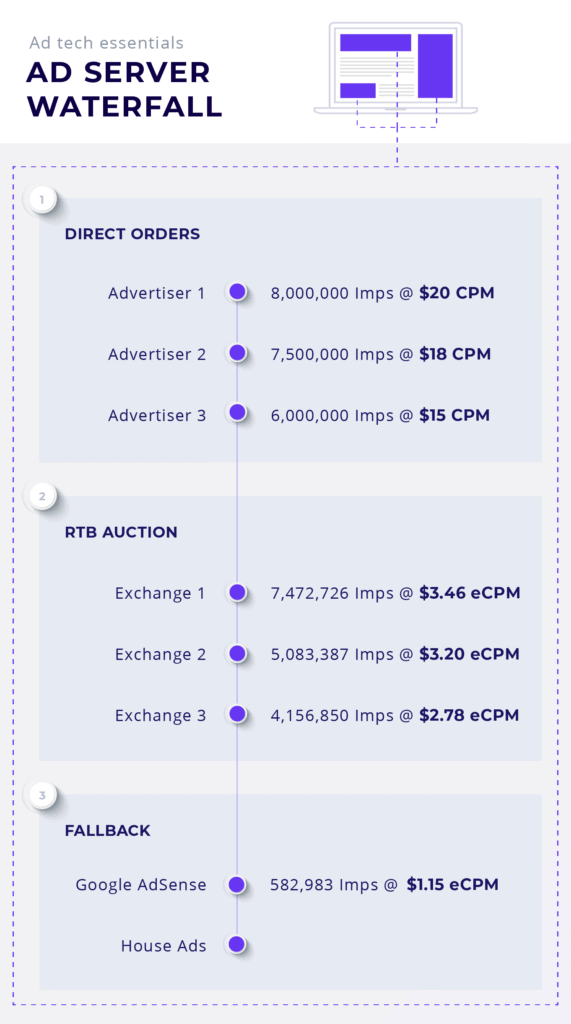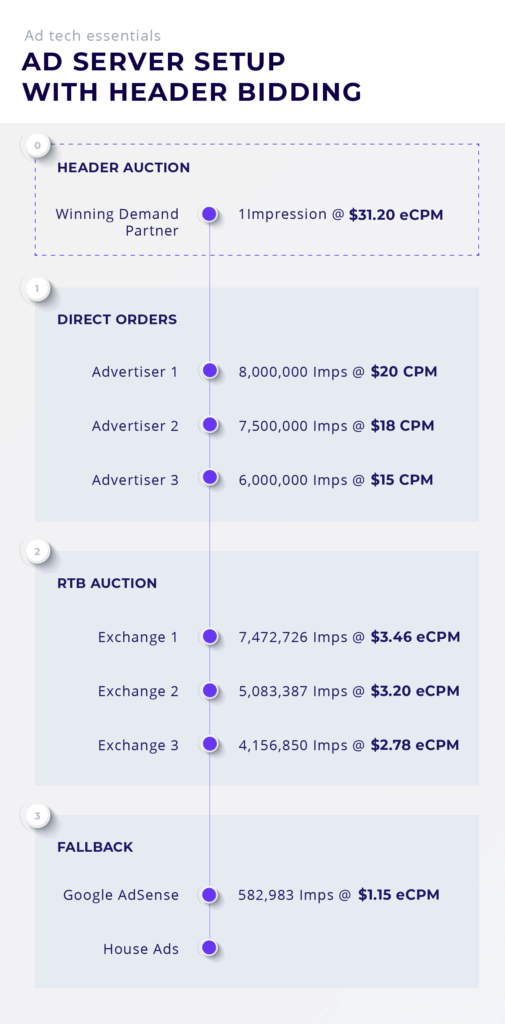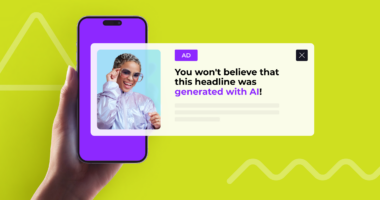You’ve definitely come across the term “Header Bidding” when reading or visiting DSP platforms. But have you ever stopped to wonder what it actually is?
Header bidding is often used in programmatic advertising to maximize profitability and efficiency. Next to Real Time Bidding (RTB), it’s one of the best things to come out of digital advertising to even the playing field for publishers and advertisers.
What Header Bidding is: Definition
Header bidding is a standardized auction for ad space handled by the publisher where advertisers can cherry-pick the impressions to buy.
Previously, auctions for ad space were only initiated when a web page already started loading. The publisher would serve the auction through waterfall bidding which looked like this:

In waterfall bidding, Direct Orders who made previous deals to receive a certain amount of impressions had priority. This was beneficial for both parties because publishers wouldn’t lose the chance to sell inventory since the Direct Orders reserved them.
Once the Direct Orders were exhausted or frequency capping on non-unique visitors were hit, the auction would fall to RTB, where various advertisers could bid to buy the ad space. If no floor prices or no demand was there, the publisher sold to a fallback source like Google AdSense, usually at very low prices to prevent unsold ad space.
Header Bidding vs Waterfall
Although many websites today still use this waterfall method, Header Bidding is breaking the mold. Auctions using Header Bidding can take place before the waterfall bidding auction because it’s in the header of the webpage, which loads before anything else. That means that publishers can get bids higher than the price of their Direct Orders.
So What’s All the Fuss About Header Bidding?
Header Bidding is financially beneficial for both publishers and advertisers. Let’s discuss how each party benefits.
More Revenue for Publishers
In the traditional waterfall bidding method, the price of an auctioned visit decreases at each subsequent buyer. Inventory only moves on to the next buyer or grouping (Direct Orders, RTB auction, Fallback) when inventory has no demand at its designated floor price which always starts with Direct Order.
This means that RTB auctions only receive inventory that Direct Orders don’t want. This leads to a reputation that RTB auctions only sell sub-par quality traffic when in reality, advertisers never get an equal opportunity to bid on all available traffic.

With header bidding, publishers can auction off ad space to every available advertiser without changing their original bidding strategy, because header bidding happens before everything else. By putting all the demand partners in an auction, every buyer gets an equal chance to bid and win ad space a publisher is willing to sell, if they bid high enough.
This header bidding strategy has reported to have added around a 50% increase in revenue and a decrease in the amount of inventory going to fallback sources.
Better Inventory for Advertisers
Now that publishers open header bidding auctions to all demand partners, advertisers have the opportunity to buy premium traffic they never had access to before. Advertisers can finally buy new traffic, not just the unsold bits of the waterfall strategy. The only exception is the case of PMPs (private marketplace deals).
Thanks to header bidding, RTB is no longer seen as an auction for remnant traffic. Instead, it now associates with the opportunities for premium traffic.
Programmatic advertising, which once had a reputation as a direct-response remnant-quality channel is now becoming the go-to method for publishers who aren’t afraid to break traditional methods to get the most out of advertisers eager to buy their inventory.
How Does Header Bidding Actually Work?
Publishers place a code in the header of their webpage. This code is executed when a user visits their website. As soon as that happens the user’s browser pings all the demand partners (ie. OpenX, AppNexus, Criteo) at the same time and asks them “Do you want this user to see your ad? How much will you pay?”.
In the course of a few milliseconds, they all return a bid. The publisher can then select the highest bid.
Header Bidding vs RTB
First and Second price auctions play a part in this process because advertisers who bid higher than the final price that won the bid do not necessarily win. But no worries, you don’t need to understand this process in order to fully comprehend Header Bidding.
So all the magic is happening before the page even loads. What about latency? Latency exists in the traditional waterfall setup as well, however it was always prevalent during the page load. Although header bidding can add latency to a webpage, publishers can manage timeouts so that no demand partner can jeopardize the performance of their site.
That’s about it on the basics of header bidding. If you want to know how to implement header bidding and you don’t mind fiddling with some javascript, I recommend checking out the Getting Started guide from Prebid.js.
Even Best Ads REquire Ad Tracker
Header bidding allows you to get publisher’s prime real estate and not scraps. But this is far from the only factor that makes good native ad campaigns. You still need to make sure that you haven’t wasted the spot you got from header bidding and that this spot is even worth your money.
To learn all this, get the Voluum ad tracker and see the efficiency of your marketing efforts:
- Learn how many conversions was generated by a concrete publisher
- Create and apply whiltelists and blacklists automatically, even if your DSP doesn’t allow that
- Analyze who responds to your ads best and tune your traffic targeting criteria.
- …and much more!
Voluum tracker works with all popular DSP platforms and ad networks out of the box. No need for complex setup processes, as API integrations and token templates reduce the amount of work to just a few clicks.




